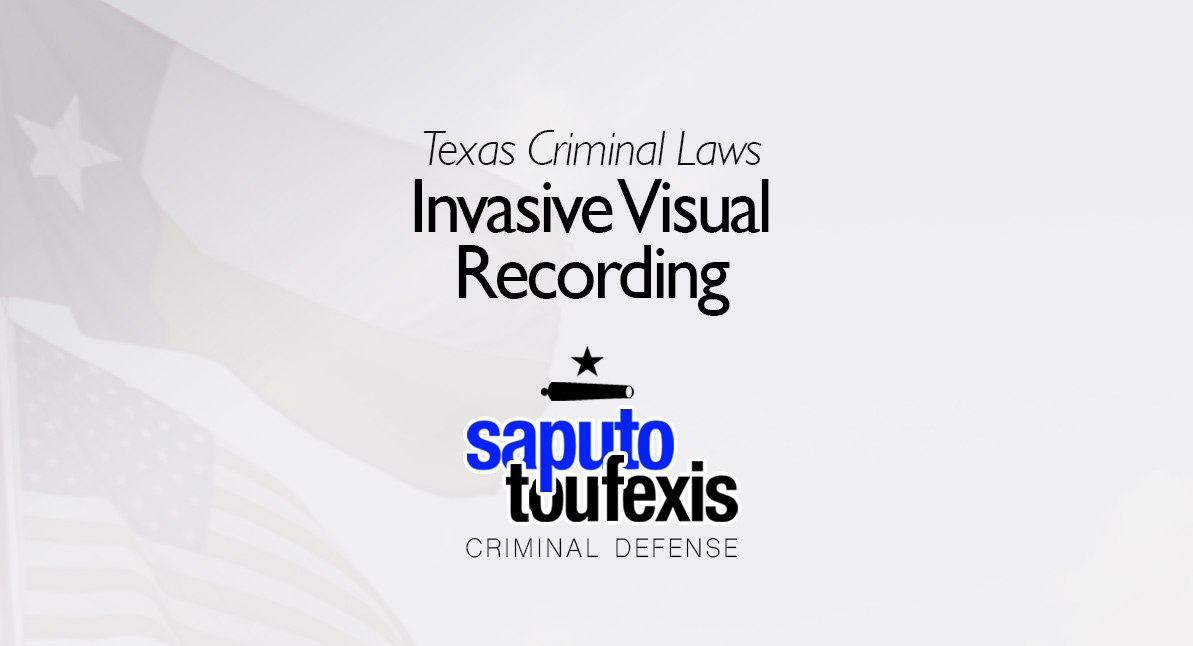The Texas Invasive Visual Recording law gives police the right to arrest you if they believe you without the other person’s consent and with intent to invade that person’s privacy, took or promoted any photograph or video of (1) someone’s “intimate area” or (2) a person in a place where there is a reasonable expectation of privacy.
FAQs about the
Invasive Visual Recording law in Texas
- What is the current Texas law about Invasive Visual Recording?
- What is the penalty for a Texas Invasive Visual Recording offense?
- What changed in 2025?
- How can I be charged with an Invasive Visual Recording offense in Texas?
- What is the statute of limitations for Invasive Visual Recording in Texas?
- Can you get probation for Invasive Visual Recording in Texas?
- Do I have to register as a sex offender in Texas if guilty of Invasive Visual Recording?
- What level of crime is Invasive Visual Recording in Texas?
In 2001, the Texas legislature codified this offense in Texas Penal Code Section 21.15. For years, lawyers had argued that this original version of this law, called Improper Photography or Visual Recording, was overly broad and unconstitutional. Eventually, the Texas Court of Criminal Appeals invalidated the statute.
Have you been charged with Invasive Visual Recording? Contact us today to discuss legal representation.
or Text or Call (888) 239-9305
The legislature responded by updating and renaming the law, now known as the Texas Invasive Visual Recording law. The current Invasive Visual Recording statute differs from the original version of the statute in that it does not require prosecutors to establish that the defendant intended to arouse or gratify sexual desires. This change simplifies the process for the District Attorney to secure convictions. This offense is now known as the “peeping Tom” or “creeping” crime.
In 2025, the legislature amended the statute by expanding its applicability beyond bathroom and changing rooms to all places in which someone might have a “reasonable expectation of privacy” and made the offense registrable under the sex offender registration rules.
We have primarily seen this law, the “upskirt law,” prosecuted in cases involving hidden cameras in bathrooms and changing areas. Hidden camera cases often hinge on establishing a link between the camera and the person accused of putting it there.
The Penal Code classifies the Texas Invasive Visual Recording law under Title 5 “Offenses Against the Person,” Chapter 21 “Sexual Offenses.” Learn more about the Texas offense of Invasive Visual Recording below.
What is the current Texas law about Invasive Visual Recording?
AV Preeminent Texas lawyer Paul Saputo provides the current law defining Invasive Visual Recording in Penal Code Section §21.15, as follows:[1]
(b) A person commits an offense if, without the other person’s consent and with intent to invade the privacy of the other person, the person:
(1) photographs or by videotape or other electronic means records, broadcasts, or transmits a visual image of an intimate area of another person if the other person has a reasonable expectation that the intimate area is not subject to public view;
(2) photographs or by videotape or other electronic means records, broadcasts, or transmits a visual image of another person in a place in which a person has a reasonable expectation of privacy; or
(3) knowing the character and content of the photograph, recording, broadcast, or transmission, promotes a photograph, recording, broadcast, or transmission described by Subdivision (1) or (2).
The 84th Texas Legislature significantly amended this law in response to Ex parte Thompson.[2] In that case, the Texas Court of Criminal Appeals struck down a law called Improper Photography or Visual Recording as substantially overbroad.[3] The legislature amended the Improper Photography or Visual Recording law and retitled it Invasive Visual Recording.[4]
Also note that this current version of the law only applies to offense conduct after September 1, 2025. Charges related to offenses that occurred prior to that date would be governed by the old law, which only covered bathrooms and changing rooms – not all places in which a person has a reasonable expectation of privacy.
Definition of intimate area
The law defines Intimate area for the purposes of this subsection as “the naked or clothed genitals, pubic area, anus, buttocks, or female breast of a person”[5] “Female breast” is defined in this subsection as “any portion of the female breast below the top of the areola.”[6]
Definition of Changing Room
Changing room is defined in this section as “a room or portioned area provided for or primarily used for the changing of clothing and includes dressing rooms, locker rooms, and swimwear changing areas”[7]
Definition of Promotes
Promotes is defined in this section as “to manufacture, issue, sell, give, provide, lend, mail, deliver, transfer, transmit, publish, distribute, circulate, disseminate, present, exhibit, or advertise, or to offer or agree to do the same”[8]
Definition of Reasonable expectation of privacy
Reasonable expectation of privacy is now expressly defined as “a place in which a reasonable person would believe that the person could disrobe in privacy, without being concerned that the act of undressing would be photographed or visually recorded by another or that a visual image of the person undressing would be broadcasted or transmitted by another.” The statute clarifies that this includes bathrooms, bedrooms, and changing rooms.[9]
What is the penalty for a Texas Invasive Visual Recording offense?
A conviction for Invasive Visual Recording in Texas is punished as a state jail felony,[10] with confinement from 180 days to two years and a fine of up to $10,000.
But do you have to register as a sex offender if you’re convicted of Invasive Visual Recording?
What changed in 2025?
In 2025, the Legislature amended the Invasive Visual Recording law in two significant ways:
- Added to sex offender registration requirements. The Legislature amended Article 62.001(5)(A) of the Code of Criminal Procedure to include Invasive Visual Recording among the offenses requiring sex offender registration.[11]
- Broadened offense conduct. The Legislature revised §21.15(b)(2) to prohibit photographing, recording, broadcasting, or transmitting images of another person in any place with a reasonable expectation of privacy—not just bathrooms or changing rooms.[12] The legislature then defined this phrase as a place where a reasonable person would believe they could disrobe in privacy, including bathrooms, bedrooms, and changing rooms:[13]
“Place in which a person has a reasonable expectation of privacy” means a place in which a reasonable person would believe that the person could disrobe in privacy, without being concerned that the act of undressing would be photographed or visually recorded by another or that a visual image of the person undressing would be broadcasted or transmitted by another. The term includes a bathroom, bedroom, and changing room.
These 2025 changes apply only to offenses committed on or after September 1, 2025 – earlier conduct remains governed by prior law.[14]
How can I be charged with an Invasive Visual Recording offense in Texas?
You can be charged with Invasive Visual Recording in Texas if the state’s attorneys believe that each of the elements of §21.15(b) as described in the section above have been met.
The state’s attorneys can use your cell phone or camera against you, and they can obtain internet records that can provide information related to the use of virtually any device connected to the internet. Also, an accuser can simply tell the police that you were involved in the taking of the pictures or video, and then the prosecuting attorneys can demand that the person testifies against you.
What is the statute of limitations for Invasive Visual Recording in Texas?
Invasive Visual Recording offenses have a three-year limitations period.[15]
Can you get probation for Invasive Visual Recording in Texas?
The Texas Code of Criminal Procedure allows both judges and juries to grant probation for Invasive Visual Recording, and judges are also allowed to accept deferred adjudication plea deals.[16]
Note, however, that no matter the offense, neither judges nor juries may recommend community supervision for any suspended sentence of over 10 years.[17] Also, judges may not grant community supervision after a conviction if (1) the defendant used or exhibited a deadly weapon during the commission of the felony or immediate flight thereafter and (2) the defendant used or exhibited the deadly weapon himself or was a party to the offense and knew that a deadly weapon would be used or exhibited.[18]
Do I have to register as a sex offender in Texas if guilty of Invasive Visual Recording?
When the legislature first created the Invasive Visual Recording offense in 2001, it was not included in the list of reportable offenses under Chapter 62 of the Texas Code of Criminal Procedure.[19]
In 2025, the legislature amended Article 62.001(5)(A) to expressly add Invasive Visual Recording to the definition of a “reportable conviction or adjudication.” This means that convictions, adjudications, and deferred adjudications for Invasive Visual Recording now require sex-offender registration.[20]
This change applies only to offenses committed on or after September 1, 2025.[21] Earlier conduct remains governed by prior law, and earlier convictions or adjudications are not reportable.[22]
What level of crime is Invasive Visual Recording in Texas?
The Penal Code classifies the punishment for Invasive Visual Recording as a state jail felony.
Learn more about the penalty range for this offense in the section above.
Legal References:
^1. Texas Penal Code §21.15. This law is current as of 2025.^2. Ex parte Thompson, 442 S.W.3d 325 (Tex. Crim. App. 2014)^3. See Texas’ highest criminal court strikes down ‘improper photography’ statute by the Washington Post^4. SB 1317, 84th Legislature (RS), Sections 1 & 2^5. Texas Penal Code §21.15(a)(2)^6. Texas Penal Code §21.15(a)(1)^7. Texas Penal Code §21.15(a)(3)^8. This definition is from subsection (a)(5) of the Obscenity law. Texas Penal Code §21.15(a)(4) says: ”Promote has the meaning assigned by Section 43.21.” Section 43.21 is the Obscenity law, so the definition provided in that statute applies to this offense.^9. Texas Penal Code §21.15(a)(3-a) says:
“Place in which a person has a reasonable expectation of privacy” means a place in which a reasonable person would believe that the person could disrobe in privacy, without being concerned that the act of undressing would be photographed or visually recorded by another or that a visual image of the person undressing would be broadcasted or transmitted by another. The term includes a bathroom, bedroom, and changing room.
Added by HB 1465, 89th Legislature (RS), Section 2^10. Texas Penal Code §21.15(c)^11. See Code of Criminal Procedure Art. 62.001(5)(A), as amended by HB 1465, 89th Legislature (RS), Section 1^12. See Texas Penal Code §21.15(b)(2), as amended by HB 1465, 89th Legislature (RS), Section 3^13. See Texas Penal Code §21.15(a)(3-a), as added by HB 1465, 89th Legislature (RS), Section 2^14. See HB 1465, 89th Legislature (RS), Section 4 (applicability), Section 5 (effective date)^15. See Code of Criminal Procedure §12.01(11)^16. See Chapter 42A, Texas Code of Criminal Procedure, Art. 42A.054, Art. 42A.056, Art. 42A.102^17. Art. 42A.053(c), Texas Code of Criminal Procedure^18. Art. 42A.054(b), Texas Code of Criminal Procedure^19. See HB 1465, 89th Legislature (RS), Section 1 (showing prior law)^20. See Code of Criminal Procedure Art. 62.001(5)(A), as amended by HB 1465, 89th Legislature (RS), Section 1^21. See HB 1465, 89th Legislature (RS), Section 5 (effective date)^22. See HB 1465, 89th Legislature (RS), Section 4 (applicability), Section 5 (effective date)










